Updated Wednesday, Jan. 20, 09:37 EST
TAKEAWAY: Usually January elections barely make a noise in America, but not this one. Voters in the state of Massachusetts have elected a Republican new senator to replace the late Edward Kennedy. The headlines are bold, big and, some even in all caps, indicating the magnitude of the event. We show you some of the front pages here. PLUS: Show Me the Money: The NY Times announces its plan to charge for online

Make that headline big and bold!

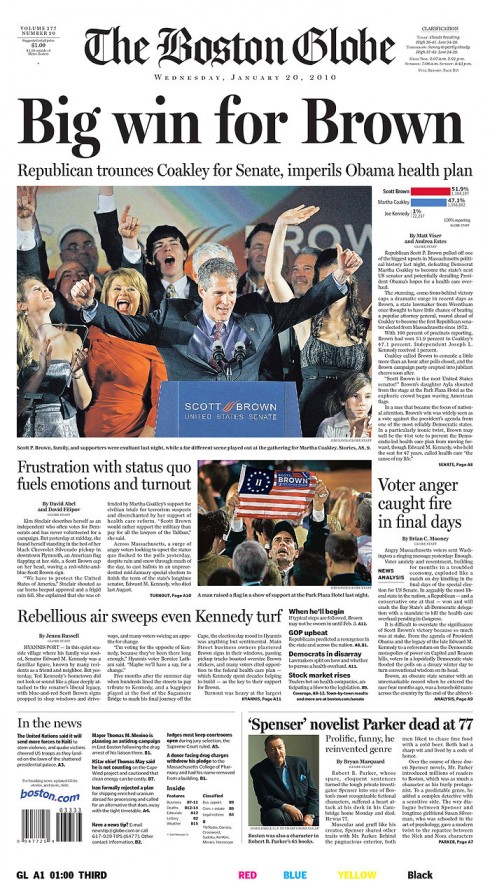
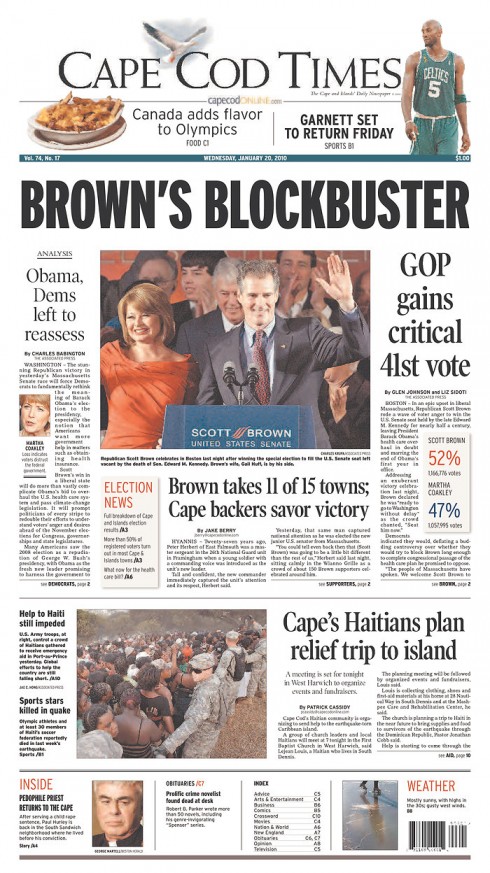
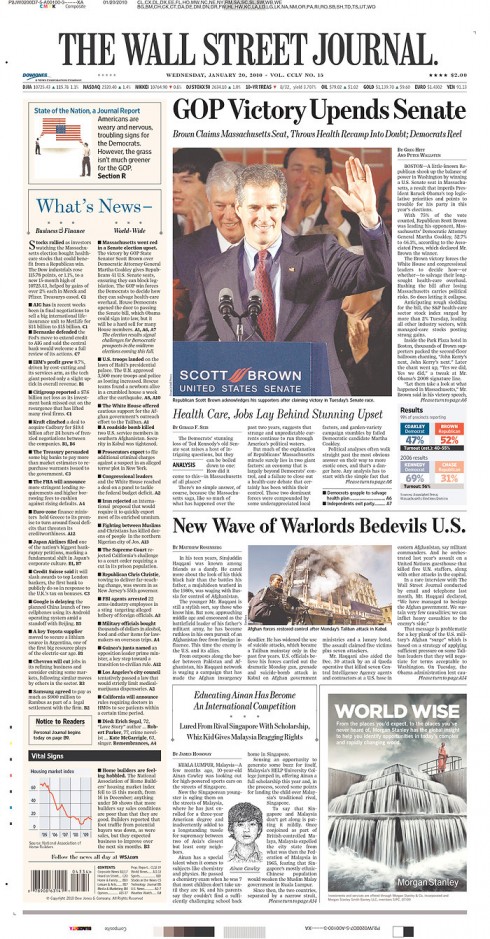
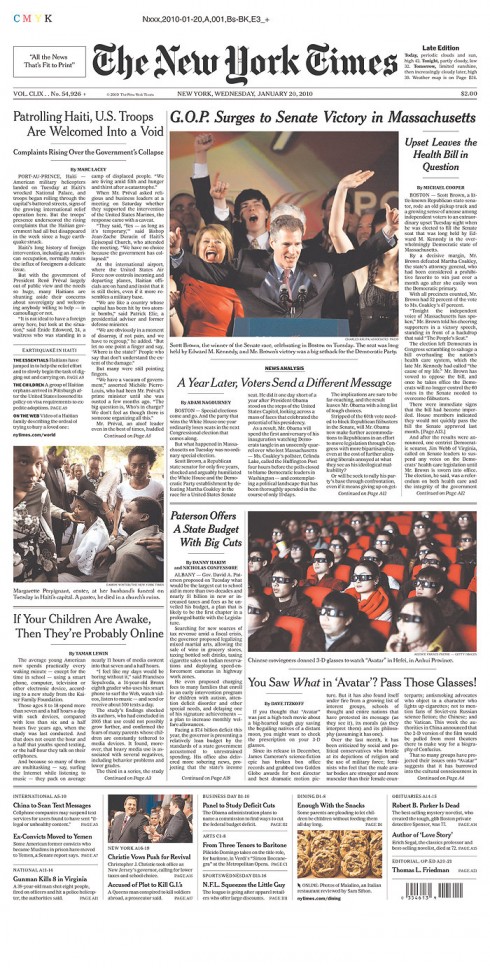
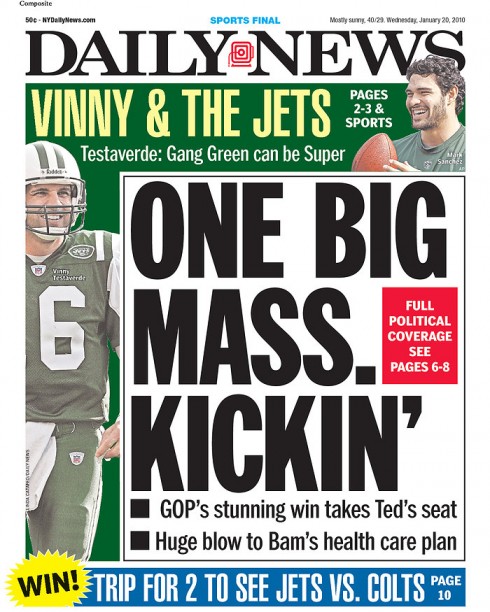

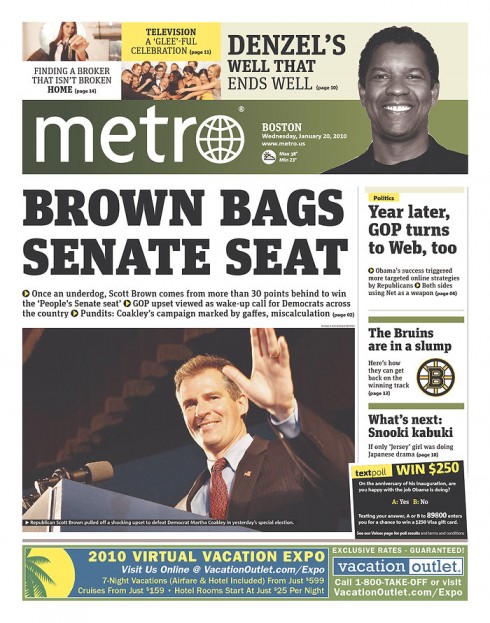
Here is a sampling of how Massachusetts newspapers covered the political story of the year so far. I could not resist the two New York City tabloids, who took the story and ran with it, creating the best headlines of all.

The new Senator Brown posed for a Cosmopolitan centerfold when he was a college student in 1982
It is exactly one year to the day since President Obama took the oath and charmed the world as the man who would bring change and hope to an America that desperately wanted it.
So, it was in that spirit that I had planned to devote the blog today to various “media celebrations” of the President’s first year. I was ready to peruse front pages of American newspapers, look into editorial pages online, just to sample what grades editors assigned President Obama one year into his presidency. I am still interested in doing that. However, the front pages of American newspapers today are dominated by a different kind of political story——ironic that it should be the front page story of January 20, 2010.
What’s the story?
Well, for those NOT reading US news, here it is in a nutshell: Scott Brown, a little-known Republican state senator who rode an old pickup truck during his campaign appearances, was elected to fill the Senate seat that was long held by Edward M. Kennedy in the overwhelmingly Democratic state of Massachusetts.
Why is that important? I am sure that is the question from many readers of this blog outside the US. However, this was an election that every American was watching closely, sort of a report card on the Obama presidency, if you will, and one that is likely to change how votes go in Congress for the President’s much discussed health care plan. Brown, who was once a Cosmopolitan magazine centerfold as a college student in 1982, defeated Martha Coakley, the state’s attorney general, who was considered the hands down favorite to win, since in such a traditionally Democratic state. Brown had 52 percent of the vote to Ms. Coakley’s 47 percent.
The election of Republican Brown now left Democrats in Congress scrambling to try to salvage a bill overhauling the nation’s health care system, a centerpiece of the Obama presidency as well. Brown has campaigned on the issue of opposing the bill, and once he takes office the Democrats will no longer control the 60 votes in the Senate needed to overcome filibusters from the Republicans.
It should be interesting to see what happens next in the American political landscape, but it is likely to get lively, and we should turn our attention from the front pages of today to the editorial pages of the next few days. It is as if politics has thrown a juicy, meaty bone to every editorial and column writer out there, which will make for fascinatingly provocative January reading as the snow falls and readers hybernate with their newspapers or in front of their computer screens.
Times announces plans to charge for online content

Not that it surprised anyone, but this NY Times news alert just came into my mobile phone, and we are likely to see many other newspapers imitating the Times in its efforts to start charging users for visits to their websites. It is the “Show Me the Money” year, I wrote January 6, and we will continue to observe these developments with great interest.
The Times to Charge for Frequent Access to Its Web Site
Starting in early 2011, visitors to NYTimes.com will get a
certain number of articles free every month before being
asked to pay a flat fee for access.
Read More:
http://www.nytimes.com/2010/01/21/business/media/21times.html?hp&emc=na
Related stories:
– USA: ‘Slim’ Times option
http://www.nypost.com/p/news/business/slim_times_option_SGOaNEprAzXot824zZ8FAL
– USA: How The New York Times Should Charge For Content
http://paidcontent.org/article/419-how-the-new-york-times-should-charge-for-content/
– USA: New York Times paywall: how it should work
http://www.guardian.co.uk/media/greenslade/2010/jan/18/new-york-times-micropayments-metered-system
– USA: Can newspaper muckraking carry on in nonprofits?
http://news.yahoo.com/s/ap/20100118/ap_on_bi_ge/us_nonprofit_muckraking


When Mario Garcia Jr. takes a weekend trip to Florida’s Disney World with his family, he realizes how user friendly the whole Disney experience is, and thinks that web designers could turn to Mickey for some lessons.
Go to Garcia Interactive for Mario Jr.‘s blog:
http://garciainteractive.com/blog/view/52/
TheMarioBlog post #461